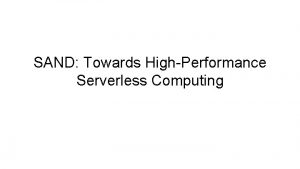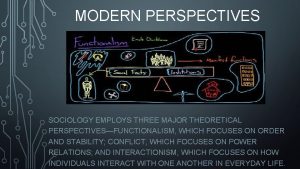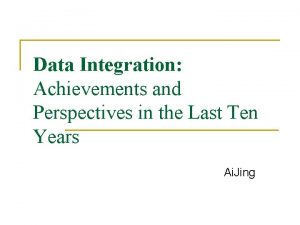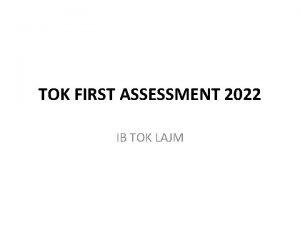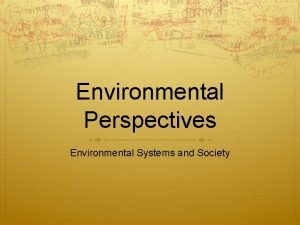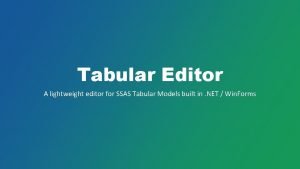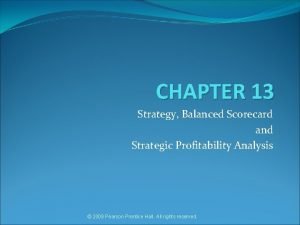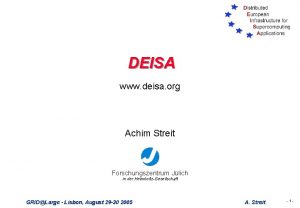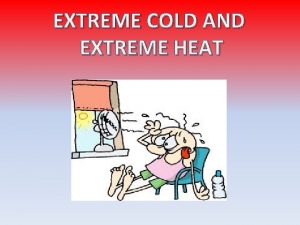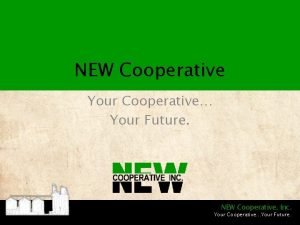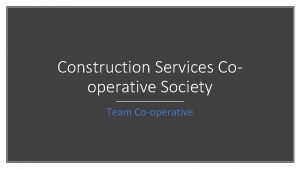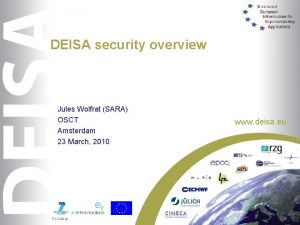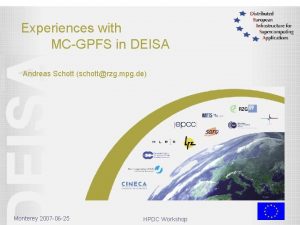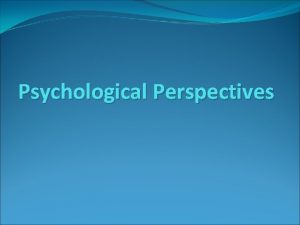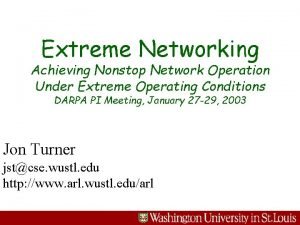DEISA Perspectives Towards cooperative extreme computing in Europe














- Slides: 14

DEISA Perspectives Towards cooperative extreme computing in Europe Victor Alessandrini IDRIS - CNRS va@idris. fr Fourth EGEE Conference Pise, October 23 -28, 2005

DEISA objectives • To enable Europe’s terascale science by the integration of Europe’s most powerful supercomputing systems. • Enabling scientific discovery across a broad spectrum of science and technology is the only criterion for success • DEISA is an European Supercomputing Service built on top of existing national services. This service is based on the deployment and operation of a persistent, production quality, distributed supercomputing environment with continental scope. • The integration of national facilities and services, together with innovative operational models, is expected to add substantial value to existing infrastructures. • Main focus is High Performance Computing (HPC). Fourth EGEE Conference Pise, October 23 - 28, 2005 V. Alessandrini, IDRIS-CNRS 2

The DEISA Supercomputing Environment • IBM AIX Super-cluster – FZJ-Julich, 1214 processors, 6, 8 teraflops peak – RZG – Garching, 748 processors, 3, 8 teraflops peak – IDRIS, 1024 processors, 6. 7 teraflops peak – CINECA, 512 processors, 2, 6 teraflops peak – CSC, 512 processors, 2, 6 teraflops peak – ECMWF, 2 systems of 2276 processors each, 33 teraflops peak • BSC, IBM Power. PC Linux system (Mare. Nostrum) 4864 processeurs, 40 teraflops peak • SARA, SGI ALTIX Linux system, 1024 processors, 7 teraflops peak • LRZ, Linux cluster (2. 7 teraflops) moving to SGI ALTIX system (5120 processors and 33 teraflops peak in 2006, 70 teraflops peak in 2007) • HLRS, NEC SX 8 vector system, 646 processors, 12, 7 teraflops peak. Fourth EGEE Conference Pise, October 23 - 28, 2005 V. Alessandrini, IDRIS-CNRS 3

AIX SUPER-CLUSTER, September 2005 Services: Services CSC ECMWF High performance datagrid via GPFS Access to remote files use the full available network bandwidth Job migration across sites Used to load balance the global workflow when a huge partition is allocated to a DEISA project in one site Common Production Environment • Full production status of dedicated (reserved bandwidth) 1 Gb/s network • GPFS : Full production at FZJ, RZG, IDRIS, CINECA; CSC and ECMWF to follow • JOB MIGRATION: test status in all sites, production expected in November 2005. Fourth EGEE Conference Pise, October 23 - 28, 2005 V. Alessandrini, IDRIS-CNRS 4

HPC and Grid computing • Grid computing is not always HPC. • Message Passing latencies are boosted in WANs from a few microseconds to millisecond, because the speed of light is not big enough. • Deploying tightly coupled parallel applications in large scale grids may not be compatible with high performance requirements • Direct Grid computing works best for (almost) embarasingly parallel applications, or coupled softwere modules with limited real time communications. • It is better to run large, tightly coupled parallel applications in a single platform. • DEISA implements this resuirement by rerouting jobs and balancing the computational workload at a European scale. • A co-scheduling service will enable deployment of weakly coupled parallel applications on several platforms Fourth EGEE Conference Pise, October 23 - 28, 2005 V. Alessandrini, IDRIS-CNRS 5

Heterogeneous Grid services roadmap Fourth EGEE Conference Pise, October 23 - 28, 2005 • Extension of GPFS to non-AIX Linus systems. GPFS will work also on the extended Grid. Extensions to SGI Altix is validated. Mare. Nostrum can also be integrated in DEISA’s GPFS • Workflow applications. Based on UNICORE plus further extensions coming from EU funded projects. Available today. • Co-allocation. Needed to support Grid applications running on the heterogeneous environment. First generation co-allocation service to be implemented by Platform Computing • Global data management. Implementing access to distributed data, fast data transfers across sites, hierarchical data management at a continental scale. First services expected in 2006 • Science Gateways and Portals; Specific Internet interfaces to hade complex supercomputing environments from end users, and facilitate the access of new, non traditional users communities. V. Alessandrini, IDRIS-CNRS 6

DEISA Service Activities roadmap DEISA (existing) SA 1: Networking SA 2: Global File Systems SA 3: Middleware SA 4: User Support SA 5: Security e. DEISA (starting operation, not yet EU funded) e. SA 2: Operations e. SA 4: Applications Enabling e. SA 5: Visualization and Portals Fourth EGEE Conference Pise, October 23 - 28, 2005 V. Alessandrini, IDRIS-CNRS 7

Dedicated network roadmap (secured) Today: FZJ IDRIS RZG CINECA LRZ Provided by GEANT and NRENs SARA 2006 Six sites connected with dedicated bandwidth at 1 Gb/s 2006: FZJ IDRIS • Ten sites connected at 1 Gb/s RZG LRZ CINECA • Four sites connected at 10 Gb/s (proof of concept network platform) CSC ECMWF SARA BSC 1 Gb/s AIX site 10 Gb/s Other OS. HLRS Fourth EGEE Conference Pise, October 23 - 28, 2005 V. Alessandrini, IDRIS-CNRS 8

Dedicated network roadmap (planned) DEISA platforms All DEISA computing platforms connected at 10 Gb/s to a central router in Germany. 2007: Provided by GN 2 and NRENs Star topology. 2008 ? Scalable topology, internal backbone, N x 10 Gb/s Two or three entry pointd for 10 Gb/s links coming from supercomputers. Supercomputers Fourth EGEE Conference Pise, October 23 - 28, 2005 V. Alessandrini, IDRIS-CNRS 9

Enabling science • Initially, DEISA had an « early users » program: a number of Joint Research Activities integrated in the project from the start • As some services in the infrastructure reached production quality, we moved towards « exceptional users » • The DEISA Extreme Computing Initiative: identification, deployment and operation of a number of « flagsjip » applications in selected areas of science and technology. • Applications are selected on the basis of scientific excellence, innovation potential and relevance criteria (the application must require the extended infrastructure services) • European call for proposals: April 1 st -> May 30, 2005 (to be repeated evey year) • Evaluation Juin -> September 2005. • 2005 -2006 projects are starting operation. Fourth EGEE Conference Pise, October 23 - 28, 2005 V. Alessandrini, IDRIS-CNRS 10

Adapting applications to the infrastructure: the ATASKF • Creation, in April 2005, of the Applications Task Force (ATASKF), to support the Extreme Computing Initiative. • The ATASKF carries out a prospective action with the European Scientific community. It provides guidance to find the best fit betweed the users requirements and the DEISA supercomputing environment. • For accepted projects, the ATASKF takes all the actions needed to adapt and optimize the aplications for efficient operation in the DEISA environment • Most demanded actions are: hyperscaling of parallel applications, data management and improved I/O, workflows. • We had in 2005 53 Extreme Computing proposals. • 29 projects were retained for operation in 2005 -2006. Full information on DEISA Web server (www. deisa. org) after November 8, 2005. Fourth EGEE Conference Pise, October 23 - 28, 2005 V. Alessandrini, IDRIS-CNRS 11

Extreme Computing proposals • • • Bioinformatics 4 Biophysics 3 Astrophysics 11 Fluid Dynamics 6 Materials Sciences 11 Cosmology 3 Climate, Environment 5 Quantum Chemistry 5 Plasma Physics 2 QCD, Quantum computing 3 Profiles of applications in operation in 2005 – 2006 • Huge parallel applications running in single remote nodes (dominant) • Data Intensive applications of different kinds. • Workflows (about 10%) Fourth EGEE Conference Pise, October 23 - 28, 2005 V. Alessandrini, IDRIS-CNRS 12

Projects from Plasma Physics Extreme Gyrokinetic Turbulence Simulations (related to ITER project) The nonlinear particle-in-cell code TORB uses a Monte Carlo particle approach to simulate the time evolution of turbulent field structures in fusion plasmas (J. Nuehrenberg, IPP, Greifswald & L. Villard, CRPP, Lausanne) Within DEISA, TORB has been improved for extreme scalability at IBM system at ECMWF: On 2048 procs: Speedup = 1680 Parallel efficiency = 82% Sustained performance = 1. 3 TF 64 nodes = 2048 processors Fourth EGEE Conference Pise, October 23 - 28, 2005 V. Alessandrini, IDRIS-CNRS 13

Conclusions • DEISA adopts Grid technologies to integrate national supercomputing infrastructures, and to provide an European Supercomputing Service. • Service activities are supported by the coordinated action of the national center's staffs. DEISA operates as a virtual European supercomputing centre. • The big challenge we are facing is enabling new, first class computational science. • DEISA aims at deploying a persistent, basic European infrastructure for general purpose high performance computing. • Interfaced with other grid-enabled complementary infrastructures, DEISA expects to contribute to a global European e. Infrastructure for science and technology • Integrating leading supercomputing platforms with Grid technologies may enable new research dimensions in Europe. Fourth EGEE Conference Pise, October 23 - 28, 2005 V. Alessandrini, IDRIS-CNRS 14
 Camera angle types
Camera angle types Sand: towards high-performance serverless computing
Sand: towards high-performance serverless computing Conventional computing and intelligent computing
Conventional computing and intelligent computing Three major theoretical perspectives in sociology
Three major theoretical perspectives in sociology Perspectives tok
Perspectives tok Data integration problems approaches and perspectives
Data integration problems approaches and perspectives Perspectives on ideology
Perspectives on ideology The six personal perspectives
The six personal perspectives Major perspectives in psychology
Major perspectives in psychology Tok theme
Tok theme Technocentrism anthropocentrism and ecocentrism
Technocentrism anthropocentrism and ecocentrism Tabular editor 3
Tabular editor 3 Global perspectives essay topics
Global perspectives essay topics Point of views
Point of views Strategic profitability analysis
Strategic profitability analysis

